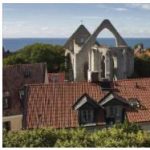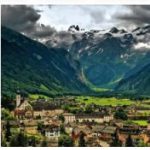The castle, which was completed in the 17th century, is located on the island of Lovö in Lake Mälaren. The former summer residence is now the seat of the royal family. The palace theater is one of the best preserved baroque theaters in Europe.
Drottningholm Palace: facts
| Official title: | Drottningholm Royal Summer Palace |
| Cultural monument: | “Versailles of the North” and residence of the royal family with the historic palace theater and 30 original stage sets |
| Continent: | Europe |
| Country: | Sweden |
| Location: | Lovön Island in Lake Mälaren (Stockholm) |
| Appointment: | 1991 |
| Meaning: | the best example of an 18th century Northern European residence |
Drottningholm Palace: history
| 1661 | Fire in a previous building |
| 1662-1700 | New construction of a castle according to plans by Nicodemus Tessin the Elder Ä. |
| 1690-99 | Construction of the castle chapel |
| around 1700 | Planting the French garden |
| 1744 | Castle owned by the Prussian princess Lovisa Ulrika |
| 1750 | Creation of a rococo garden near the Chinese pavilion |
| 1763-69 | Construction of the Chinese palace |
| 1766 | Completion of the palace theater |
| 1777 | State takeover |
| 1791 | Construction of the “Gothic Tower” |
| 1850 | new equipment of the Reichssaal |
| 1906-13 | restoration |
| 01/19/1922 | After the restoration of the palace theater, the theater started |
| 1974 | Restoration of the marbling of the stairwell walls |
| 1998/99 | Restoration of the so-called »Déjeunersalons« of the castle theater |
| 1999 | Replanting of the box hedges of the embroidery parterre; Continuation of the renewal of the linden avenues |
A China castle as a royal present
It was a truly royal present: “He took me a little off the beaten track in the pleasure garden, and I was completely surprised when I suddenly found myself in front of a veritable work of magic. The king had a Chinese castle built, the most beautiful one can imagine, ”was how the Prussian princess Lovisa Ulrika described the birthday present from her husband Adolf Frederik in a letter to her mother in July 1753. The night before, the Swedish monarch had the wooden pavilion shipped to Drottningholm on the waterway. The then seven-year-old Crown Prince, who later became Gustav III. was supposed to give the palace its current appearance, completed the successful surprise when he, disguised as a Chinese prince, presented his mother with the gold-plated keys on a velvet cushion.
For Lovisa Ulrika, her husband’s proof of love was also a reminder of home, because in Prussia the chinoiserie was very fashionable at the time. If her brother Friedrich had a Chinese tea house built in the park in Potsdam, she now had a castle for her summer residence. When the wooden pavilion fell into decay after ten years, there was no doubt that a new one should be built, more durable this time, bigger, richer. This is where the royal entourage made his excursions when the regent wanted some relaxation, because in the China-Schlösschen there was a more casual tone and a less rigid dress protocol. Then the king had the carriage harnessed, and the servants strolled afterwards: a quarter of an hour’s walk through the palace gardens to the Chinese enclave. The China-Schlösschen has never been inhabited: it does have a bedroom, but does not contain a bed, just a very narrow sofa to relax on. Its original furniture from the 18th century has been preserved to this day.
There was a royal estate on the island of Lovön as early as the 16th century, and the first castle was left here by Johann III. build his Queen Catherine. Since then, the place has been called Drottningholm, “Queen’s Island”. After a fire destroyed this building, the construction of a new residence began on behalf of the king’s widow Hedvig Eleonora. For more than a hundred years, the complex grew to its present form. But it was not until 1981, when Queen Silvia wanted to bring her children from downtown Stockholm to the idyllic Drottningholm, that the pleasure palace, which had previously been used less and less, became the permanent residence of the royal family.
The south wing of the palace has since been closed to the public, and a part of the park is also reserved for the residents’ privacy. But Drottningholm is the only palace in Europe that is open to the public, even when the royal family is at home. The number of visitors has increased, how could it be otherwise, since Drottningholm became the royal residence, although no guest can expect to meet the queen for a chat while strolling through the palace gardens. But the park is also worth seeing without its royal splendor: the French-inspired baroque garden is surrounded by an open landscape that Gustav III. was laid out according to the English model.
According to dentistrymyth, the English Park adjoins the Castle Theater, whose theater hall can be described as the showpiece of Drottningholm. The candles in the candlesticks have meanwhile been replaced by subdued electric light, but otherwise the visitor is captured by the unadulterated atmosphere of the 18th century. The deep, slightly rising stage, the manually operated sliding gates, the wind and thunder machines, which consist of a crank and boxes with stones that can be operated by a rope, the rolls of which make the thunderstorm rumble – everything is as in those times, in whom Gustav III. Gluck had it performed and ignored Mozart because he didn’t like his happy music. With the operas and ballets from the Baroque period or his concerts with authentic instruments from the 18th.









